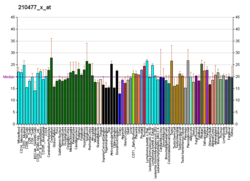Top Qs
Timeline
Chat
Perspective
MAPK8
Protein-coding gene in the species Homo sapiens From Wikipedia, the free encyclopedia
Remove ads
Mitogen-activated protein kinase 8 (also known as JNK1) is a ubiquitous enzyme that in humans is encoded by the MAPK8 gene.[5][6]
Remove ads
Function
The protein encoded by this gene is a member of the MAP kinase and JNK family. MAP kinases act as an integration point for multiple biochemical signals, and are involved in a wide variety of cellular processes such as proliferation, differentiation, transcription regulation and development. This kinase is activated by various cell stimuli, and targets specific transcription factors, and thus mediates immediate-early gene expression in response to cell stimuli. The activation of this kinase by tumor-necrosis factor alpha (TNF-alpha) is found to be required for TNF-alpha-induced apoptosis. This kinase is also involved in UV radiation-induced apoptosis, which is thought to be related to the cytochrome c-mediated cell death pathway. Studies of the mouse counterpart of this gene suggested that this kinase play a key role in T cell proliferation, apoptosis and differentiation. Four alternately spliced transcript variants encoding distinct isoforms have been reported.[7] MAPK8 contains multiple amino acid sites that are phosphorylated and ubiquitinated.[8]
Remove ads
Interactions
MAPK8 has been shown to interact with:
- Activating transcription factor 2,[9][10][11][12]
- C-jun,[5][12][13][14][15][16][17][18]
- CRK,[19]
- DUSP10,[20]
- DUSP1,[21]
- GSTP1,[22]
- IRS1,[23][24]
- ITCH,[25][26]
- MAP2K4,[11][12][27][28][29]
- MAP2K7,[12][27]
- MAP3K1[30]
- MAP3K2,[27]
- MAPK8IP1,[31][32]
- MAPK8IP3,[33][34]
- Myc,[35]
- REL,[13]
- SH3BP5,[36] and
- SPIB.[37]
References
Further reading
External links
Wikiwand - on
Seamless Wikipedia browsing. On steroids.
Remove ads







